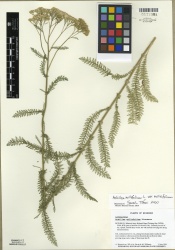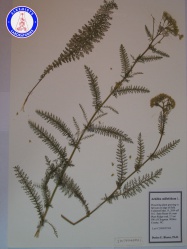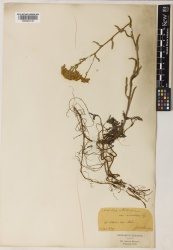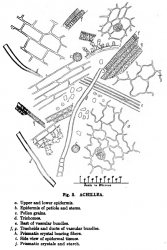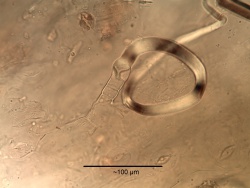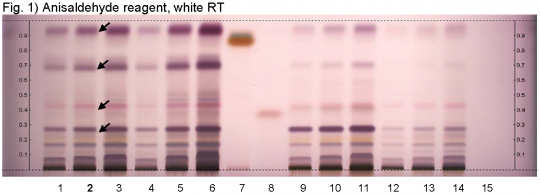Achillea millefolium (flower)
(add flavonoid reference) |
|||
| (33 intermediate revisions by 3 users not shown) | |||
| Line 1: | Line 1: | ||
| − | + | {{DISPLAYTITLE:''Achillea millefolium'' (flower)}} {{askbox|herb=''Achillea millefolium''}} | |
| − | '' | + | =Nomenclature= |
| + | {{nomenclature | binomial=Achillea millefolium | ||
| + | |authority=L. | ||
| + | |family=Asteraceae | ||
| + | |scn=yarrow | ||
| + | |syn= | ||
| + | |ayurvedic= | ||
| + | |pinyin= | ||
| + | |aka=milfoil | ||
| + | |notes= }} | ||
| − | + | =Botanical Voucher Specimen= | |
| − | + | {{Media3 |cat=Voucher | |
| + | | companyimage=TropicosLogo.gif | ||
| + | | companyURL=http://www.tropicos.org/Image/88582 | ||
| + | | mainimage=Achillea millefolium Tropicos 88582.jpg | ||
| + | | source=Tropicos.org. Missouri Botanical Garden. 05 Aug 2013 | ||
| − | + | | companyimage2=AP-LOGO-Laboratories Crop - Copy.jpg | |
| + | | companyURL2=http://www.alkemist.com | ||
| + | | image2=Achillea_millefolium_IG17404BMX1_A0001.jpg | ||
| + | | source2=Botanical Voucher Specimen Library, Alkemists Laboratories | ||
| − | + | | companyimage3=Kewlogo.gif | |
| − | = | + | | companyURL3=http://specimens.kew.org/herbarium/K000942133 |
| + | | image3=Achillea millefolium Kew imageBarcode=K000942133 488979.jpg | ||
| + | | source3=Royal Botanic Gardens, Kew. | ||
| − | + | }} | |
| − | + | ||
| − | + | ||
| − | + | ||
| − | + | ||
| − | + | ||
| − | + | ||
| − | |||
| + | =Organoleptic Characteristics= | ||
| + | |||
| + | =Macroscopic Characteristics= | ||
| + | {| border=1 | ||
| + | | | ||
| + | {{Macroscopy | source=American Medicinal Plants of Commercial Importance (1930) | ||
| + | | description=[Yarrow] is from 10 to 20 inches high and has many finely divided, feathery dark-green leaves. From June to September the plant produces flat-topped panicles consisting of numerous small, white flower heads. | ||
| + | }} | ||
| + | |} | ||
| + | =Microscopic Characteristics= | ||
| + | {| border=1 | ||
| + | | | ||
{{Microscopy | source=Schneider, A. (1921) The Microanalysis of Powdered Vegetable Drugs, 2nd ed. | {{Microscopy | source=Schneider, A. (1921) The Microanalysis of Powdered Vegetable Drugs, 2nd ed. | ||
| − | |||
| − | |||
| color=Grayish green. | | color=Grayish green. | ||
| flavor=Bitter, astringent, somewhat saline. | | flavor=Bitter, astringent, somewhat saline. | ||
| Line 32: | Line 53: | ||
| }} | | }} | ||
| − | {{Microscopy | | + | {{media2 |cat=Microscopy |
| − | + | |companyimage2=AP-LOGO-Laboratories Crop - Copy.jpg | |
| − | + | | companyURL2=http://www.alkemist.com | |
| − | + | |mainimage=Microanalysis_powdered_vegetable_p_204_google_ver_achillea.png | |
| − | + | |source=Schneider, A. (1921) The Microanalysis of Powdered Vegetable Drugs, 2nd ed. | |
| + | |image2=Achillea millefolium trichome.jpg | ||
| + | |caption2=Hair cells simple with one to six basal cells and long apical cell; walls moderately thick, smooth. 400X Acidified chloral Hydrate Soln. | ||
| + | |source2=Elan M. Sudberg, Alkemist Laboratories}} | ||
| + | |||
| + | |} | ||
| + | =High Performance Thin Layer Chromatographic Identification= | ||
| + | |||
| + | {{HPTLC | source=HPTLC Association | ||
| + | | companyimage=HPTLC-assoc-Logo-farbig-Text-schwarz-300x47.png | ||
| + | | companyURL=http://www.hptlc-association.org/ | ||
| + | | mainimage= Achillea millefolium-whiteRT-hptlc-association.png | ||
| + | | caption1=Yarrow (flower) HPTLC ID - Anisaldehyde reagent, white RT | ||
| + | | description=Yarrow (flower) (''Achillea millefolium'') | ||
| + | | | ||
| + | | stationaryphase=Stationary phase, i.e. Silica gel 60, F254 | ||
| + | | mobilephase=Tolulene, ethyl acetate 95:5 (v/v) | ||
| + | | prep=Sample: Mix 1.0 g of powdered sample with 10 mL of methanol and sonicate for 10 minutes, then centrifuge or filter the solutions and use the supernatants / filtrates as test solutions. | ||
| + | |||
| + | Derivatization reagent: Anisaldehyde reagent; Preparation: 170 mL of ice cooled methanol are mixed with 20 mL of acetic acid, 10 mL of sulfuric acid, and 1 mL of anisaldehyde. Use: Dip (time 0, speed 5), heat at 100°C for 4 min. | ||
| + | | detection=Saturated chamber; developing distance 70 mm from lower edge; relative humidity 33% | ||
| + | | referencesamples=Reference: Dissolve 25 mg of cineole in 20 mL of tolulene. Dissolve 10 mg of guaiazulene in 20 mL of tolulene. | ||
| + | | | ||
| + | | lanes= Lanes, from left to right (Track, Volume, Sample): | ||
| + | # 8 µL Yarrow flower 1 | ||
| + | # 16 µL Yarrow flower 1 | ||
| + | # 32 µL Yarrow flower 1 | ||
| + | # 1 µL Yarrow flower 1 (Ph. Eur extr.) | ||
| + | # 3 µL Yarrow flower 1 (Ph. Eur extr.) | ||
| + | # 6 µL Yarrow flower 1 (Ph. Eur extr.) | ||
| + | # 2 µL Guaiazulene | ||
| + | # 5 µL Cineole | ||
| + | # 8 µL Yarrow flower 2 | ||
| + | # 16 µL Yarrow flower 2 | ||
| + | # 32 µL Yarrow flower 2 | ||
| + | # 8 µL Yarrow flower 3 | ||
| + | # 16 µL Yarrow flower 3 | ||
| + | # 32 µL Yarrow flower 3 | ||
| + | |||
| + | |||
| + | | notes=Images presented in this entry are examples and are not intended to be used as a bases for setting specifications for quality control purposes. | ||
| + | |||
| + | System suitability test: | ||
| + | Cineole: violet zone at Rf ~ 0.38. | ||
| + | Guaiazulene: brown zone at Rf ~ 0.88. | ||
| + | |||
| + | Application: 2 µL of references, 16 µL of test solutions | ||
| + | |||
| + | Identification: | ||
| + | Compare result with reference images. The fingerprint of the test solution is similar to that of the corresponding botanical reference sample. Additional weak zones may be present. The chromatogram of the test solution shows a violet zone at Rf ~ 0.94 right above the zone due to guaiazulene reference substance. Below this zone there is a violet zone at Rf ~ 0.70. There is a reddish-violet zone at Rf ~ 0.43 right above the zone due to cineole reference substance. Below this zone there is a violet zone at Rf ~ 0.29 (black arrows). | ||
| + | | }} | ||
| + | |||
| + | =Supplementary Information= | ||
| + | ===CE/HPLC flavonoid determination, Kocevar, ''et al.'', 2008=== | ||
| + | '''Comparison of capillary electrophoresis and high performance liquid chromatography for determination of flavonoids in ''Achillea millefolium'',''' | ||
| + | <blockquote>'''Abstract.''' | ||
| + | |||
| + | Flavonoids represent an important bioactive component in ''Achillea millefolium''. The comparison of the most commonly used analytical methods for the identification and quantification of flavonoids, capillary electrophoresis (CE) and high performance liquid chromatography (HPLC), is presented. The methods were optimized and validated. Using a 20 mM borate buffer with 30% (v/v) of methanol (pH 9.3) in the CE analysis and a gradient elution with water–acetonitrile mobile phase in the HPLC analysis, sufficient separation of the analytes was achieved. A relatively high injection volume in the CE analysis (30 mbar × 30 s) enabled low limit of detection (LOD) (0.3–0.7 mg/L). Repeatability of both methods was acceptable (relative standard deviation of peak area were <6%). Additionally, the amount of flavonoids in a real sample of the dried herbal drug was determined.<ref>Kočevar, N., Glavač, I., Injac, R., Kreft, S., 2008. Comparison of capillary electrophoresis and high performance liquid chromatography for determination of flavonoids in ''Achillea millefolium'' ''Journal of Pharmaceutical and Biomedical Analysis'' 46(3), 609-614. http://dx.doi.org/10.1016/j.jpba.2007.11.016</ref></blockquote> | ||
| + | =Sources= | ||
| − | + | <references /> | |
| − | + | ||
Latest revision as of 19:31, 26 April 2016
Contents |
Nomenclature
Achillea millefolium L. Asteraceae
Standardized common name (English): yarrow
Botanical Voucher Specimen
 |
 |
|
|
|
|
|
Organoleptic Characteristics
Macroscopic Characteristics
|
Microscopic Characteristics
|
High Performance Thin Layer Chromatographic Identification
|
Yarrow (flower) (Achillea millefolium) Lane Assignments Lanes, from left to right (Track, Volume, Sample):
Reference Sample(s) Reference: Dissolve 25 mg of cineole in 20 mL of tolulene. Dissolve 10 mg of guaiazulene in 20 mL of tolulene. Stationary Phase Stationary phase, i.e. Silica gel 60, F254 Mobile Phase Tolulene, ethyl acetate 95:5 (v/v) Sample Preparation Method Sample: Mix 1.0 g of powdered sample with 10 mL of methanol and sonicate for 10 minutes, then centrifuge or filter the solutions and use the supernatants / filtrates as test solutions. Derivatization reagent: Anisaldehyde reagent; Preparation: 170 mL of ice cooled methanol are mixed with 20 mL of acetic acid, 10 mL of sulfuric acid, and 1 mL of anisaldehyde. Use: Dip (time 0, speed 5), heat at 100°C for 4 min. Detection Method Saturated chamber; developing distance 70 mm from lower edge; relative humidity 33% Other Notes Images presented in this entry are examples and are not intended to be used as a bases for setting specifications for quality control purposes. System suitability test: Cineole: violet zone at Rf ~ 0.38. Guaiazulene: brown zone at Rf ~ 0.88. Application: 2 µL of references, 16 µL of test solutions Identification: Compare result with reference images. The fingerprint of the test solution is similar to that of the corresponding botanical reference sample. Additional weak zones may be present. The chromatogram of the test solution shows a violet zone at Rf ~ 0.94 right above the zone due to guaiazulene reference substance. Below this zone there is a violet zone at Rf ~ 0.70. There is a reddish-violet zone at Rf ~ 0.43 right above the zone due to cineole reference substance. Below this zone there is a violet zone at Rf ~ 0.29 (black arrows).
|
Supplementary Information
CE/HPLC flavonoid determination, Kocevar, et al., 2008
Comparison of capillary electrophoresis and high performance liquid chromatography for determination of flavonoids in Achillea millefolium,
Abstract. Flavonoids represent an important bioactive component in Achillea millefolium. The comparison of the most commonly used analytical methods for the identification and quantification of flavonoids, capillary electrophoresis (CE) and high performance liquid chromatography (HPLC), is presented. The methods were optimized and validated. Using a 20 mM borate buffer with 30% (v/v) of methanol (pH 9.3) in the CE analysis and a gradient elution with water–acetonitrile mobile phase in the HPLC analysis, sufficient separation of the analytes was achieved. A relatively high injection volume in the CE analysis (30 mbar × 30 s) enabled low limit of detection (LOD) (0.3–0.7 mg/L). Repeatability of both methods was acceptable (relative standard deviation of peak area were <6%). Additionally, the amount of flavonoids in a real sample of the dried herbal drug was determined.[9]
Sources
- ↑ Tropicos.org. Missouri Botanical Garden. 05 Aug 2013 http://www.tropicos.org/Image/88582
- ↑ Botanical Voucher Specimen Library, Alkemists Laboratories http://www.alkemist.com
- ↑ Royal Botanic Gardens, Kew. http://specimens.kew.org/herbarium/K000942133
- ↑ American Medicinal Plants of Commercial Importance (1930)
- ↑ Schneider, A. (1921) The Microanalysis of Powdered Vegetable Drugs, 2nd ed.
- ↑ Schneider, A. (1921) The Microanalysis of Powdered Vegetable Drugs, 2nd ed.
- ↑ Elan M. Sudberg, Alkemist Laboratories http://www.alkemist.com
- ↑ HPTLC Association http://www.hptlc-association.org/
- ↑ Kočevar, N., Glavač, I., Injac, R., Kreft, S., 2008. Comparison of capillary electrophoresis and high performance liquid chromatography for determination of flavonoids in Achillea millefolium Journal of Pharmaceutical and Biomedical Analysis 46(3), 609-614. http://dx.doi.org/10.1016/j.jpba.2007.11.016
- Botanical
- Asteraceae
- Media
- Voucher
- Tropicos.org. Missouri Botanical Garden. 05 Aug 2013
- Botanical Voucher Specimen Library, Alkemists Laboratories
- Royal Botanic Gardens, Kew.
- Macroscopy
- American Medicinal Plants of Commercial Importance (1930)
- Microscopy
- Schneider, A. (1921) The Microanalysis of Powdered Vegetable Drugs, 2nd ed.
- Elan M. Sudberg, Alkemist Laboratories
- HPTLC
- HPTLC Association
